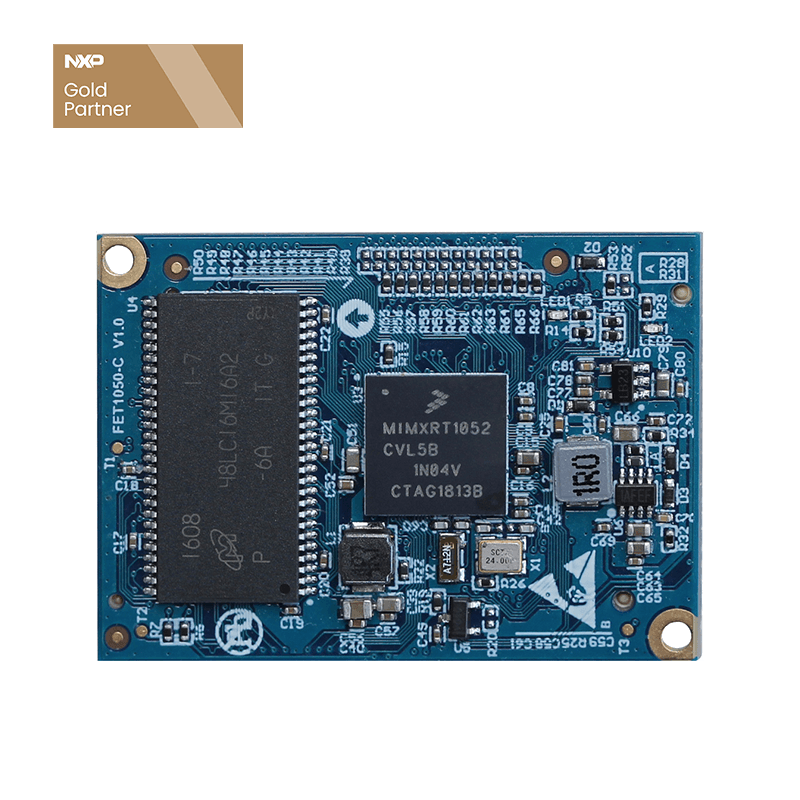
Control PMSM by iMX RT1052 som FET1052-C system on module
Motor control and precision control are new requirements of some applications, to have the device worked in optimized condition, improving motor controlling technology is critical. Thus it BLDC and PMSM are more efficient alternative solutions by manufacturers facing the challenge.
In resent years, digital control AC sever system which takes PMSM as controlling target has gradually replaced DC sever system and analog AC server system. Digital AC sever system based
on vector control can help improving controlling performance.
By NXP i.MXRT1052 processor, can control AC motor movement, speed and armature current precisely. It's a cross-over processor with low power effcient but high performancemm.
FET1052-C SoM Features
- 1.Fast response and low latency
- 2.Cortex-M7 architecture, frequency 528MHz,CoreMark 3020 /1284 DMIPS;
- 3.512KB TCM, latency as low as 20ns;
- 4.Low power consumption, integrated with DC-DC converter
High scalability
SoM can support up to 124 GPIO, also LCD, Camera, USB, UART, CAN, Ethernet and PWM.
High security
HAB with QSPIFlash, 128-bit AES and random number generator, circuit designing in full consideration of signal integrity and good electrica. Industrial grade working temperature width ranges
from -40 to 85℃ allow the device can work well in tough environment condition.
Solution details based on FET1052-C
PMSMs diagram
- 1.RS232 for PC and FET1052-C communication voltage converting;
- 2.Speed analog control input circuit for speed controlling signal by analog input;
- 3.LCD for speed displaying and HMI operating;
- 4.Optical encoder circuit for connection between optical encoder and i.MX RT1052;
- 5.Current detection circuit for U and V current detecting;
- 6.Drive and isolation circuit to isolate converter
Current detection circuit
i.MXRT1052 can support two high-accurate AD controllers and each can support up to 16 channels.
Up to 12-bit linear successive approximation algorithm with sampling rate, 1MS/s, Resolution linear successive approximation algorithm, 1MS/S sampling rate, support interrupt, and round training sampling, can realize the three-phase voltage sampling of the motor without phase compensation. But because it is unipolar, it is necessary to add a boost circuit when sampling the AC, so that the voltage range of the AC signal is between 0V and 3.3V. In this solution, 3 channels of A/D conversion inputs are used, which are 2 channels of current detection and 1 channel of analog signal input sampling. Current detection is to convert the two-phase stator current of the AC motor into the corresponding binary code to facilitate processing. Because this system is a three-phase balanced system IA+IB+IC=0, as long as two of the currents are detected, three-phase currents can be obtained. Since the output of the Hall element is a weak current signal, the current signal should be converted into a voltage signal, and then filtered and added. Because the output of the Hall current sensor is a current signal with positive and negative directions, and i.MXRT1052 The on-chip A/D converter is a voltage signal of 0-3.3V for unipolar input, so a voltage offset circuit is required.
Photoelectric coder interface circuit
i.MXRT1052 can support four ENC. It supports four quadrature decoders (ENC), using 5 input signals (PHASEA, PHASEB, INDEX, TRIGGER and HOME) from the position/speed sensor, and the quadrature decoder module adjusts the axis position, The number of revolutions and speed are decoded, and the quadrature encoding pulse circuit can be used to connect the photoelectric encoder to obtain information such as the position and speed of the rotating machinery.
Drive isolation circuit
The IR2132 produced by IR can be used to drive G4PH50UD-E (IGBT) to construct a three-phase inverter. Because the frequency of the PWM waveform generated by i.MXRT1052 is relatively high, using a general low-speed optocoupler will make the switching time of the drive circuit longer. At low speeds and small loads, it will seriously affect the low-speed performance of the motor, so you can choose a high-speed optocoupler. , Effectively improve the speed of the inverter.
i.MXRT1052 supports up to 32 PWM outputs, including PWM sub-modules, each of which is designed to control a single half-bridge power stage. Provide failure channel support. The PWM module can generate various switching patterns, including highly complex waveforms. It supports the control of all known motor types and is also ideal for controlling different switch mode power supply (SMPS) topologies.
RS232 communication and display circuit
i.MXRT1052 supports up to 8 UART and 2 CAN interfaces, which is convenient for expanding other functional applications; supports 8/16/24-bit LCD interface, supports maximum 1366×768 resolution, supports 4.3 and 7-inch resistive touch, supports 8/16 -bitMPU/8080 interface. Support 2D graphics acceleration engine, emWIN graphical interface; Forlinx embedded OK1052-C development board supports bare metal, FreeRTOS, ucLinux operating system development, which is convenient for customers' product applications in different occasions.
The MCU mode supports Keil, ARM-GCC and other compilers. It also supports Amazon FreeRTOS, SDK, ARM mbed, software libraries, online tools, and correspondingly supported global ARM ecosystems to achieve rapid prototyping and development. The MPU mode still uses the Ubuntu+GCC development method that engineers are most familiar with.
3. FET1052-C core board is divided into two configurations
This solution fully demonstrates the outstanding performance advantages of FET1052-C in motor control and the richness of interfaces. For the two PMSM motor control solutions, please refer to the application note AN12200 (Dual FOC Servo Motor Control on i.MXRT) published on the NXP official website.


